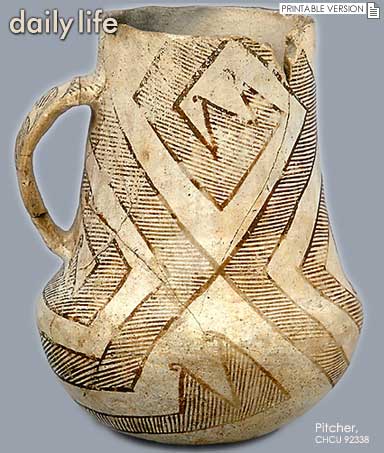| Everyday objects used at Chaco Canyon a thousand years ago remind us how similar people are through time. Like us, Chacoans needed food and water containers, building and hunting tools, and clothing. They used fire starters, awls and needles, and cordage to make life easier. Pipes, gaming pieces, and effigy figurines made their leisure time more pleasurable. Chaco Canyon is famous for its pottery. The Chacoan people used pottery for food preparation, serving, and storage. Bowls, jars, canteens, seed jars, pitchers, and ladles came in a dazzling variety of shapes and sizes. Although ceramics were present in the American Southwest by AD 200, clay cooking pots at Chaco first appear around AD 450 – 500. As Chacoans became settled farmers, they built more permanent structures, and increasingly used ceramics. Pottery was more durable, took less time to produce than basketry, and could be used over a fire for cooking. The first pots at Chaco were plain grayware. Early on, Southwestern potters began decorating their pots with black-painted geometric designs. Over time these designs became elaborate and distinctive. Highly decorated whiteware and effigy vessels may have had special uses and meanings, now lost to us. Duck shaped pots occur throughout the Anasazi sequence, but their significance is unknown. Chacoan potters also made miniatures of many vessel shapes. Some archeologists believe that children made them while learning to craft pots, or that they were toys. The arid Southwestern climate has preserved many fragile items. At Chaco Canyon, dry caves offered special protection. Sandals, cordage, bone awls and needles, and wooden fire drills have survived over a thousand years. Most of the sandals, matting, and cordage in the museum collection were recovered from a cliff shelter dwelling. Sandals and matting were woven from yucca and reeds. Cordage was made from yucca, cotton, human hair, sinew, and occasionally animal fur. Cordage was used to hang canteens and seed jars, weave feather and fur blankets, to make sandal ties, and to haft tools. Fur from animals, such as prairie dog, beaver, bear, rat, mouse, rabbit, and mountain sheep, was twisted between plies of yucca cord to create fur string. Fur string was then intertwined with turkey feathers to create fur blankets. The objects you see in here give us a tantalizing glimpse into the lives of the men, women and children of Chaco. |
|||
|
|
